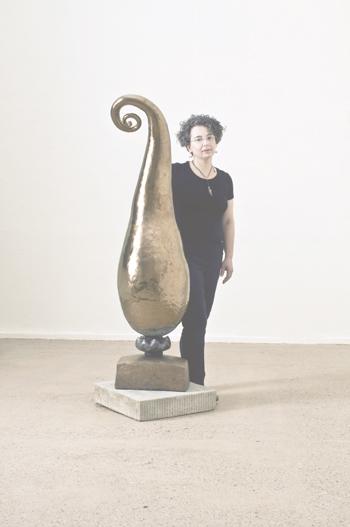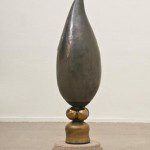Tamara Laird’s “Paisley Monuments”
By • July 26, 2011 0 1714

The Cross Mackenzie Gallery, in Canal Square in Georgetown, has kicked off their artistic season with a small but resounding triumph. “Paisley Monuments,” the gallery’s latest exhibition of DC artist Tamara Laird, brings together a playful, natural whimsy with serene elegance, offering a fittingly contemporary aesthetic in a subtle sea of history.
Laird is an accomplished professional artist and a ceramics professor at the Corcoran College of Art and Design, whose travel has had a tremendous impact on her work. When still a student, she traveled to England and met many renowned British ceramists, including Bernard Leach. She spent time in Zaire, and in 1984 moved to Nairobi, Kenya, where she worked at the National Museum of Kenya on a project funded by the United Nations and taught art at the Kenyatta University. From there, she went to Bangkok Thailand, where she conducted extensive research in local ceramics, from traditional village production to full-scale industrial ceramic factories.
She participated in a tour of ceramic factories in Mexico that integrated traditional and contemporary industrial majolica production. She currently teaches majolica techniques for an annual summer study abroad program in Amalfi, Italy. Her studies and travels all work toward Laird’s is interested in finding the connection between local cultural and artistic development.
Her current works, exhibited in “Paisley Monuments,” are ceramic sculptures based on the paisley motif, a universally recognizable pattern that has been used for thousands of years. It originated in Persian culture, as a fertility symbol among other things, inspired by the shape of the cashew nut. The shape, mainly seen patterned in fabric throughout the world, is given vibrancy and tremendous fullness in the way that Laird has transformed these symbols into sculpture. It is reminiscent of the delicate beauty of a pregnant belly, the crane of a swan’s neck, the budding of a flower in springtime, and countless other allegorical allusions throughout so many cultures of the world.
And this is precisely why the work has such power. The work prompts your imagination to engage with it.
Which is not to take away from the raw aesthetic power of the works. The texture and luster Larid is able to achieve through her glazing process is remarkable. The works are all high fire ceramics, but she uses metallic glazes, called lusters, on many of the works, giving the feeling of soft, smooth metal. While some pieces resemble the clay from which they are molded, others look equally as if they were cast in bronze.
It would be impossible to review any individual piece in the show, as they all work socialistically (Tea Partyists be warned) toward the collective strength of the show. Walking into the Cross Mackenzie Gallery amidst these sculptures, reminiscent of Brancusi and Tim Burton in the same breath, is like stepping into a garden of suspended creation.
The garden-like quality is not lost on Laird, who has designed them to be outdoor friendly, to be fit among gardens and as outdoor sculptures. She was even in a recent show at the National Botanical Gardens involving plant-inspired artwork. But don’t mistake my intentions—the works would be beautiful anywhere.
The Cross Mackenzie Gallery, at 1054 31st St NW, in Canal Square, is run by Rebecca Cross. For more information about this exhibition and others, visit CrossMackenzie.com or email Becca@CrossMackenzie.com.
- Tamara Laird with her sculpture “Couqette,” 2010



